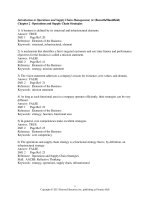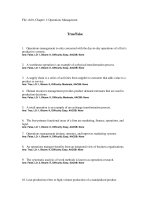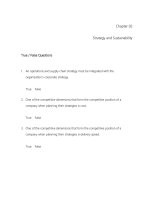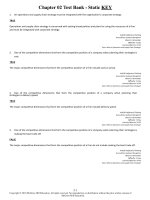Introduction to operations and supply chain management 3e bozarth chapter 03
Bạn đang xem bản rút gọn của tài liệu. Xem và tải ngay bản đầy đủ của tài liệu tại đây (434.52 KB, 38 trang )
Process Choice and Layout
Decisions in Manufacturing and
Services
Chapter 3
Chapter Objectives
Be able to:
Describe the characteristics of the five classic types of manufacturing processes.
Discuss how different manufacturing process choices support different market
requirements.
Explain how different manufacturing processes can be linked together via the supply
chain.
Describe the critical role of customization in manufacturing, including the degree and
point of customization, as well as upstream versus downstream activities.
Discuss the three dimensions that differentiate services from one another - the service
package, customization, and customer contact - and explain the different managerial
challenges driven by these dimensions.
Position a service on a conceptual model and explain the underlying managerial
challenges.
Explain how different service processes support different market requirements.
Develop a product-based layout using line balancing, and calculate basic performance
measures for the line.
Develop a functional layout based on total distance traveled.
Copyright © 2013 Pearson Education, Inc. publishing as Prentice Hall
3-2
Manufacturing Process Decisions
Consider the impact of people, facilities and
physical layouts, and information systems
working together.
Consider the effect of the manufacturing
processes on the overall business strategy.
Consider the impact of many different types
of manufacturing processes working
together.
Copyright © 2013 Pearson Education, Inc. publishing as Prentice Hall
3-3
Selecting a Manufacturing Process
What are the physical requirements of the
company’s product?
How similar to one another are the products the
company makes?
What are the company’s production volumes?
Where in the value chain does customization take
place (if at all)?
Copyright © 2013 Pearson Education, Inc. publishing as Prentice Hall
3-4
Types of Manufacturing Processes
Continuous Flow
Production Line
Batch
Job Shop
Fixed Position Layout
Copyright © 2013 Pearson Education, Inc. publishing as Prentice Hall
3-5
Continuous Flow
Large production volumes
High level of automation
Basic material passed along, converted as it moves
Usually cannot be broken into discrete units
Usually very high fixed costs and inflexible
Copyright © 2013 Pearson Education, Inc. publishing as Prentice Hall
3-6
Production Line
High-volume production of standard items with
identical or highly similar designs
• Processes arranged by product flow
• Often “paced”
• Highly efficient, but not too flexible
• Resources are arranged sequentially
Copyright © 2013 Pearson Education, Inc. publishing as Prentice Hall
3-7
Batch Manufacturing
Items are moved through the different
manufacturing steps in groups, or batches
Moderate volumes, multiple products
Sequence of steps is not as tightly linked as a
production line
Strikes a balance between the flexibility of a job
shop and the efficiency of a production line
Copyright © 2013 Pearson Education, Inc. publishing as Prentice Hall
3-8
Job Shops
General-purpose equipment and broadly skilled
workers
Functional layout: Work areas are arranged by
function
Requirements can change dramatically from one job
to the next
Highly flexible but not very efficient
Copyright © 2013 Pearson Education, Inc. publishing as Prentice Hall
3-9
Fixed-Position Layout
The position of the product is fixed.
Materials, equipment, and workers are transported
to and from the product.
Used in industries where the products are very
bulky, massive, or heavy and movement is
problematic
Copyright © 2013 Pearson Education, Inc. publishing as Prentice Hall
3 - 10
Hybrid Manufacturing Processes
A manufacturing process that seeks to
combine the characteristics and advantages
of more than one classic process.
Machining centers
Group technology
Flexible manufacturing systems
Copyright © 2013 Pearson Education, Inc. publishing as Prentice Hall
3 - 11
Hybrid Manufacturing Processes
Spindles
Combining the
characteristics
and advantages
of more than
one process to
make chairs.
Arms and
Legs
Batch for
fabricating
parts ...
Production
LINE for
putting together
final product
Seats
Copyright © 2013 Pearson Education, Inc. publishing as Prentice Hall
3 - 12
Linking Manufacturing Processes
Across the Supply Chain
Figure 3.4
Copyright © 2013 Pearson Education, Inc. publishing as Prentice Hall
3 - 13
The Product-Process Matrix
Based on R. Hayes and S. Wheelwright, Restoring Our Competitive Edge: Competing through Manufacturing (New York: Wiley, 1984)
Figure 3.5
Copyright © 2013 Pearson Education, Inc. publishing as Prentice Hall
3 - 14
Four Levels of Customization
Make-to-stock (MTS) – Products that require no
customization.
Assemble-to-order (ATO) – Products that are customized only
at the very end of the manufacturing process.
Make-to-order (MTO) – Products that use standard
components but have customer-specific final configuration
of those components.
Engineer-to-order (ETO) – Products that are designed and
produced from the start to meet unusual customer needs or
requirements.
Copyright © 2013 Pearson Education, Inc. publishing as Prentice Hall
3 - 15
Customization in the Supply Chain
Figure 3.6
Copyright © 2013 Pearson Education, Inc. publishing as Prentice Hall
3 - 16
Law of Variability
The greater the random variability either
demanded of the process or inherent in the
process itself or in the items processed, the less
productive the process is.
© Schmenner and Swink (1998)
Copyright © 2013 Pearson Education, Inc. publishing as Prentice Hall
3 - 17
Customization in the Supply Chain
When customization occurs early in the
supply chain:
Flexibility in response to unique customer needs
will be greater.
Lead times to the customer will tend to be longer.
Products will tend to be more costly.
Copyright © 2013 Pearson Education, Inc. publishing as Prentice Hall
3 - 18
Customization in the Supply Chain
When customization occurs late in the supply
chain:
Flexibility in response to unique customer needs
will be limited.
Lead times to the customer will tend to be shorter.
Products will tend to be less costly.
Copyright © 2013 Pearson Education, Inc. publishing as Prentice Hall
3 - 19
How different services are
organized and managed
The service package
The degree of customization
The level of customer contact
Copyright © 2013 Pearson Education, Inc. publishing as Prentice Hall
3 - 20
The service package
Includes all value-added physical and
intangible activities that a service
organization provides to the customer.
The greater the emphasis on physical activities, the more
attention will be directed to capital expenditures, material
costs, and other tangible assets.
The greater the emphasis on intangible activities, the more
critical are the training and retention of skilled employees
and the development of the firm’s knowledge assets.
Copyright © 2013 Pearson Education, Inc. publishing as Prentice Hall
3 - 21
Service customization
Ranges from highly customized to
standardized.
As the degree of customization increases, the
service package becomes less predictable and
more variable.
Copyright © 2013 Pearson Education, Inc. publishing as Prentice Hall
3 - 22
Customer contact
Differs from customization – relates to the
importance of front-room or back-room
operations.
Front Room – The physical or virtual point where
the customer interfaces directly with the service
organization.
Back Room – The part of a service operation that
is completed without direct customer contact.
Copyright © 2013 Pearson Education, Inc. publishing as Prentice Hall
3 - 23
Front Room vs. Back Room
Front room – what the
customer can see
Back room – what the
customer does not see
Managed for flexibility and
customer service
Managed for efficiency and
productivity
Customer lobbies, bank teller,
receptionist
Package sorting, car repair,
blood test analysis,
accounting department
Copyright © 2013 Pearson Education, Inc. publishing as Prentice Hall
3 - 24
Managerial Challenges
in Service Environments
Table 3.2
Copyright © 2013 Pearson Education, Inc. publishing as Prentice Hall
3 - 25









